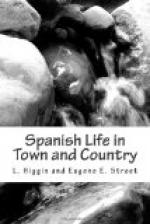Rafael Molina Lagartijo, one of the veterans of the bull-fighters, and an extreme favourite with the people for many years, died recently, after living for some time in comparative retirement in his native Cordoba. Some idea of the important place which these men occupy in Spanish society may be gathered from the numerous notices which appeared in the newspapers of all shades of political opinion after his death. I quote from the article which appeared in the charming little illustrated Blanco y Negro, of Madrid, on the favourite of the Spanish public. In what, to us, seems somewhat inflated language, but which is, however, quite simple and natural to the Spaniard, the writer began his notice thus:
“He who has heard the magic oratory of Castelar, has listened to the singing of Gayarre, the declamation of Cabro, has read Zorilla, and witnessed the torear of Lagartijo, may say, without any kind of reservation, that there is nothing left for him to admire!” Having thus placed the popular bull-fighter on a level with orators, authors, and musicians of the first rank, the writer goes on to describe the beauties of Lagartijo’s play in words which are too purely technical of the ring to make translation possible, and adds: “He who has not seen the great torero of Cordoba in the plenitude of his power will assuredly not comprehend why the name of Lagartijo for more than twenty years filled plazas and playbills, nor why the aficionados of to-day recall, in speaking of his death, times which can never be surpassed.... The toreo (play) of Lagartijo was always distinguished by its classic grace, its dignity and consummate art, the absence of affectation, or struggle for effect. In every part of the fight the figure of Rafael fell naturally into the most graceful attitudes; and for this reason he has always worn the rich dress of the torero with the best effect. He was the perfect and characteristic type of a torero, such as Spanish fancy has always imagined it. Lagartijo died with his eyes fixed on the image of the Virgen de los Dolores, to whom he had always confidently committed his life of peril, and with the dignity and resignation of a good man.”




